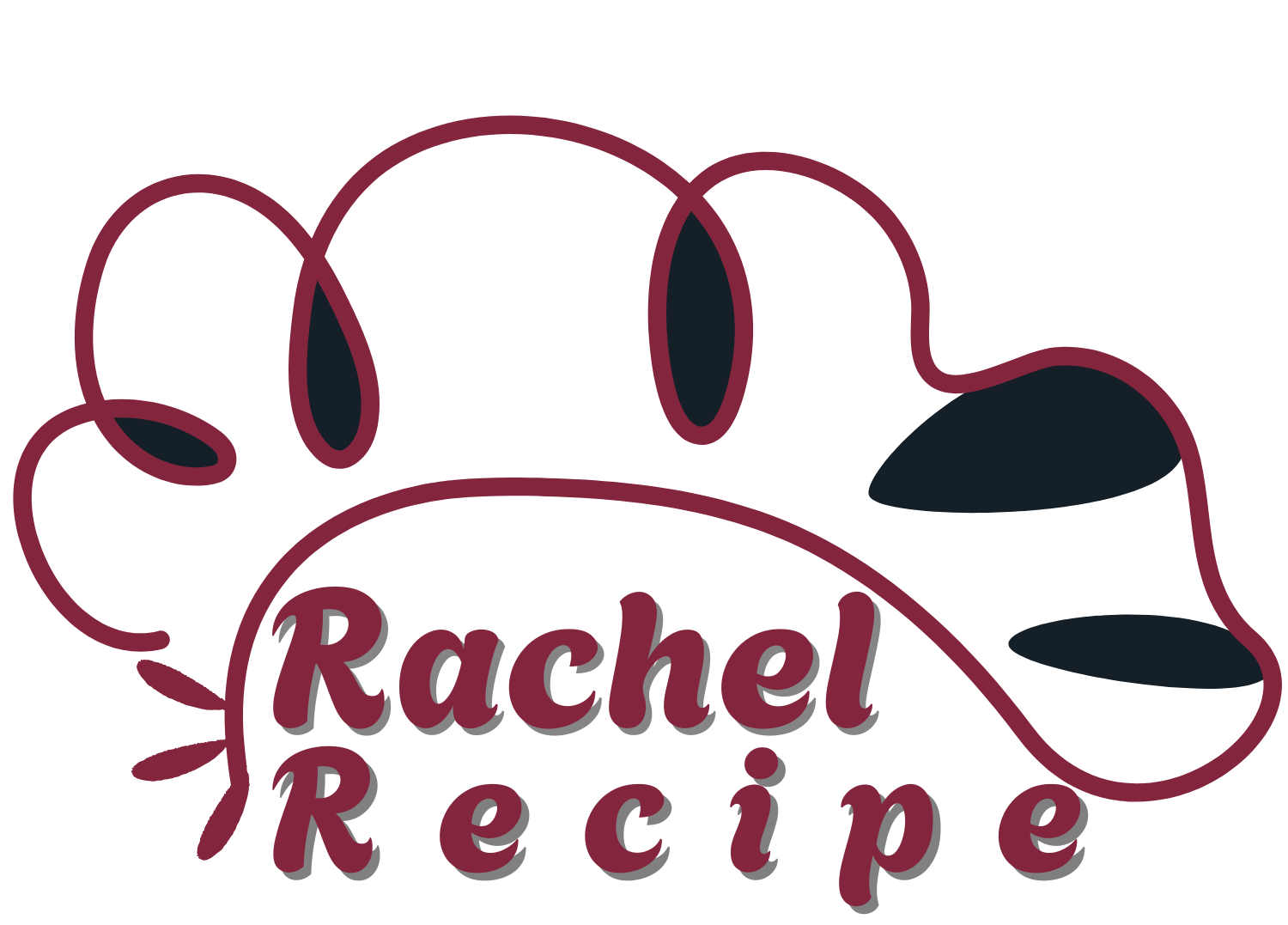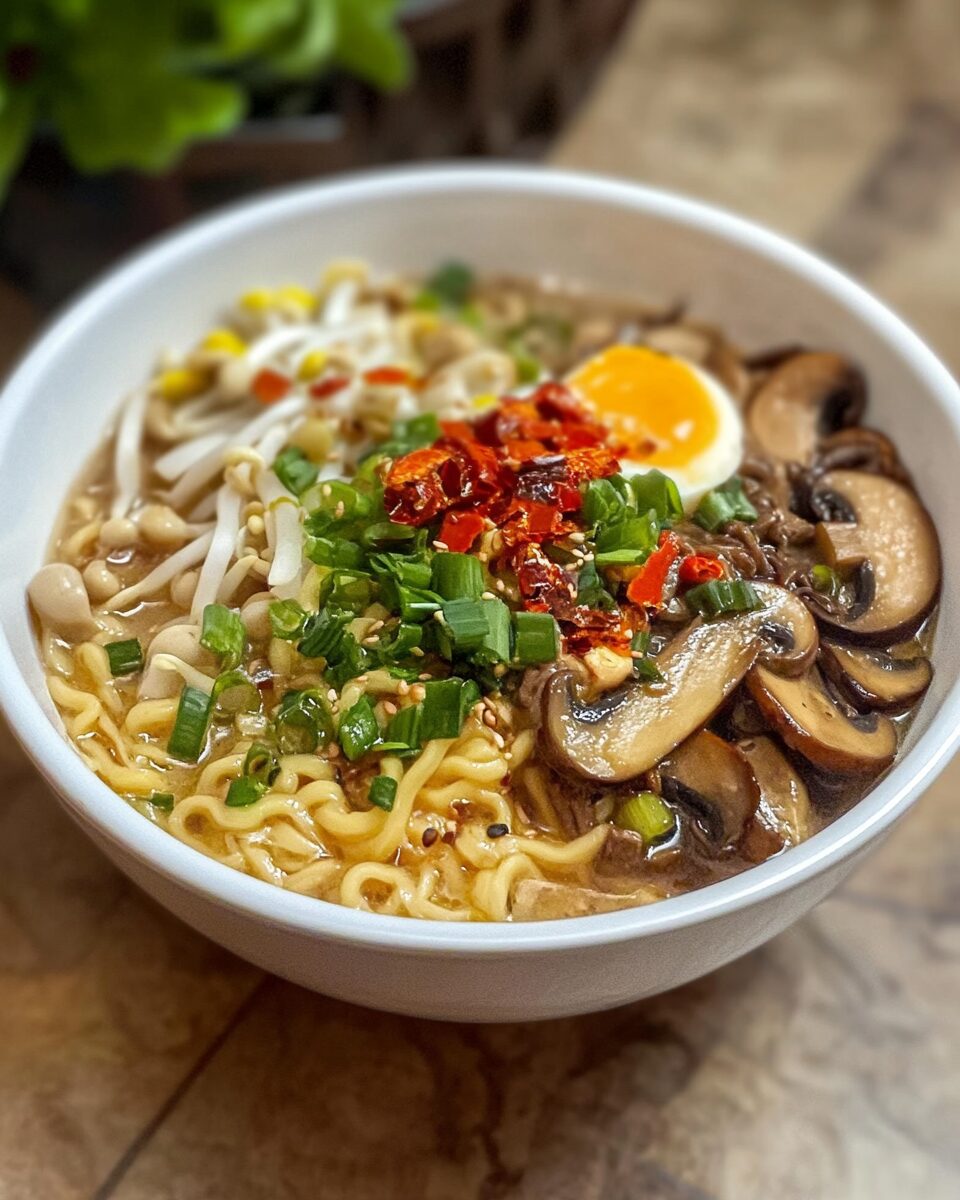This Mushroom Ramen is the ultimate bowl of comfort with a savory miso broth filled with tender mushrooms, ramen noodles, and garnished with fresh herbs and optional toppings like a boiled egg or seaweed strips.
It’s the perfect dish for any time you crave a warm, satisfying meal. The deep umami flavor of the miso paired with the richness of the mushrooms creates a comforting, hearty dish. You can easily customize it by adding extra toppings or adjusting the seasoning to your preference, making it a versatile meal that suits every craving. Whether you’re enjoying it on a chilly day or serving it for a casual dinner, this mushroom ramen will not disappoint!
Full Recipe:
-
4 cups vegetable broth
-
2 tablespoons soy sauce
-
1 tablespoon miso paste
-
1 tablespoon sesame oil
-
2 teaspoons grated ginger
-
1 garlic clove, minced
-
2 cups sliced mushrooms (shiitake or your choice)
-
4 ounces ramen noodles
-
1/4 cup chopped green onions
-
1 boiled egg, halved (optional)
-
1 tablespoon sesame seeds (optional)
-
Red chili flakes (optional)
-
Fresh cilantro (optional)
-
Seaweed strips (optional)
Directions:
-
In a large pot, combine vegetable broth, soy sauce, miso paste, sesame oil, ginger, and garlic. Bring to a simmer over medium heat.
-
Add sliced mushrooms and cook for 5-7 minutes, or until mushrooms are tender.
-
In a separate pot, cook ramen noodles according to package instructions, then drain and set aside.
-
Once the broth is ready and the mushrooms are tender, add the cooked noodles to the broth. Stir to combine and heat through for an additional 2-3 minutes.
-
Ladle the mushroom ramen into bowls and top with green onions, a boiled egg (optional), sesame seeds, red chili flakes, fresh cilantro, and seaweed strips, if desired.
-
Serve immediately and enjoy the savory flavors of your homemade mushroom ramen.
Prep Time: 10 minutes | Cooking Time: 15 minutes | Total Time: 25 minutes
Kcal: 290 kcal | Servings: 2 servings
Mushroom Ramen: A Delicious and Comforting Dish
Mushroom ramen is a flavorful and comforting dish that blends the richness of miso or soy-based broth with the earthiness of mushrooms and the satisfying texture of ramen noodles. Popularized in Japanese cuisine, ramen has evolved into a global favorite, with numerous variations highlighting regional and seasonal ingredients. Among these, mushroom ramen stands out for its depth of flavor, versatility, and ability to appeal to both vegetarians and meat-eaters alike.
History and Origins of Ramen
Ramen’s origins are a subject of debate, with many attributing it to Chinese immigrants who brought the dish to Japan in the late 19th to early 20th century. The dish evolved over time, incorporating local Japanese ingredients and flavor profiles. By the 1950s, ramen had become a staple of Japanese street food culture and was popularized globally through both international trade and the iconic instant ramen noodles, introduced by Momofuku Ando in 1958.
While traditional ramen often features meats like pork or chicken, the vegetarian and vegan variations, such as mushroom ramen, have risen in popularity due to the growing awareness of plant-based diets and the pursuit of lighter, healthier options. The combination of mushrooms with ramen adds umami, making it a perfect alternative to meat-based broths.
The Versatility of Mushroom Ramen
Mushroom ramen offers incredible flexibility when it comes to both preparation and ingredients. Mushrooms, with their rich umami flavor, can replace meat in ramen without sacrificing depth. Shiitake, portobello, and enoki mushrooms are often used, each adding its unique texture and taste. Whether used as the star ingredient or paired with other vegetables, mushrooms elevate the dish with their complex, savory profile.
In addition to the type of mushrooms used, the broth can vary based on personal preferences and regional styles. Some prefer a clear vegetable broth seasoned with soy sauce or miso for a lighter, more delicate flavor. Others may opt for a heartier, creamy broth, achieved by adding ingredients like coconut milk or tahini, which gives a rich and velvety texture. The toppings are another area of creativity, where one can add fresh vegetables, a soft-boiled egg, seaweed, sesame seeds, and even a splash of chili oil to elevate the dish.
Nutritional Benefits of Mushroom Ramen
One of the standout features of mushroom ramen is its nutritional value. It is naturally lower in calories compared to traditional meat-based ramen, making it a healthier option for those seeking a lighter meal. The mushrooms themselves are a great source of dietary fiber, antioxidants, and several important vitamins, including B vitamins like riboflavin, niacin, and pantothenic acid, which play essential roles in energy metabolism.
The combination of mushrooms with ramen noodles and a vegetable-based broth provides a balanced dish that is both filling and nourishing. The broth, often made with ingredients like miso or soy sauce, can offer a significant source of sodium, which helps maintain electrolyte balance. However, for those watching their sodium intake, a low-sodium soy sauce or homemade vegetable broth can be a great alternative.
Ramen’s carbohydrate content, primarily from the noodles, gives the body a steady energy release, while the plant-based toppings such as green onions, spinach, and bean sprouts contribute a variety of vitamins and minerals. For a more balanced dish, you can add tofu or tempeh for a plant-based protein boost. The variety of flavors and textures in the bowl also make mushroom ramen a satisfying and nutrient-packed meal.
How to Customize Your Mushroom Ramen
Mushroom ramen is easily customizable to suit a wide range of dietary preferences and taste preferences. For instance, if you’re looking for a gluten-free option, you can swap out the traditional ramen noodles for gluten-free alternatives made from rice flour or buckwheat. You can also modify the broth to fit different flavor profiles. If you want a spicy kick, adding chili paste or Sriracha to the broth can provide heat without overpowering the earthy mushroom flavor.
For those who prefer a richer broth, coconut milk or cashew cream can be added for a creamy texture, making the dish even more comforting. The topping options are nearly endless—boiled eggs, sautéed greens, or even roasted peanuts can add variety. The beauty of mushroom ramen lies in its flexibility, allowing home cooks to explore different ingredients and seasonings to make it their own.
Tips for Making the Perfect Mushroom Ramen
To make the best mushroom ramen at home, here are a few helpful tips:
-
Use fresh, high-quality mushrooms: Fresh mushrooms will provide the best flavor and texture. Depending on the variety, you can sauté the mushrooms to bring out their natural umami flavor before adding them to the broth.
-
Balance your broth: The broth is the heart of the dish, so it’s important to get the seasoning just right. If you’re using miso, soy sauce, or tamari, taste the broth before serving and adjust the seasoning as needed. A little bit of sesame oil can also add a rich, nutty depth to the broth.
-
Don’t overcook your noodles: Ramen noodles cook quickly, so it’s essential to keep an eye on them. Overcooking can lead to a soggy texture, which detracts from the overall dish. Once cooked, quickly rinse them under cold water to stop the cooking process before adding them to the broth.
-
Get creative with toppings: While green onions and sesame seeds are classic toppings for mushroom ramen, you can also add spinach, bok choy, or even avocado for a creamy, fresh contrast. Toppings not only enhance the flavor but also add visual appeal.
-
Make it ahead: If you’re short on time, you can prepare the broth and mushrooms in advance and store them in the refrigerator. This will allow you to quickly assemble your ramen when you’re ready to eat.
Mushroom Ramen Variations Around the World
While mushroom ramen is often associated with Japan, variations of this dish can be found in many different culinary traditions. For example, in Korea, a similar dish called “japchae” incorporates mushrooms and noodles, but the flavors are distinctively sweeter and spicier due to the addition of gochujang (Korean chili paste) and sesame oil. In Chinese cuisine, mushroom-based noodle soups may feature different noodle types, such as wheat or egg noodles, and often include ingredients like bok choy and tofu.
The global popularity of ramen has sparked numerous creative adaptations, making it a truly international dish. Whether enjoyed with a simple miso broth or a more complex fusion approach, the dish continues to evolve while maintaining its core comfort food qualities.
Conclusion
Mushroom ramen is a comforting, versatile, and nutritious dish that has become a favorite for many. Its rich umami flavor, ease of preparation, and flexibility make it the perfect meal for any occasion. Whether you’re looking for a vegan option, trying to cut back on meat, or simply craving a satisfying bowl of noodles, mushroom ramen offers endless possibilities. With a few simple ingredients, a little creativity, and the right seasoning, you can create a ramen dish that’s truly your own. So, next time you’re in the mood for a warm, nourishing meal, consider giving mushroom ramen a try—it’s sure to become a favorite in your recipe collection.






